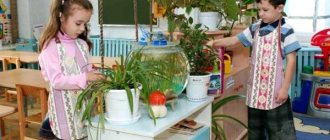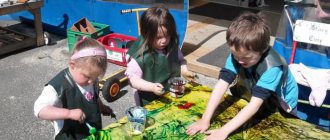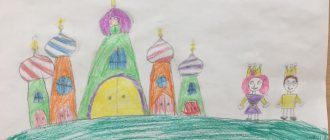Techniques for organizing work activities in the preparatory group
In introducing children to work activity, the teacher uses 3 groups of methodological techniques. The fourth group, that is, practical techniques, is a type of work activity.
Speech techniques
A group of such methods of interaction with children plays a strategic role in preparing children for verbal perception of information, which will be the main thing in school.
Explanation
In this group of techniques, the most significant is the explanation, since for successful work activity it is very important:
- explain to children why this or that task is important (for example, regularly watering a mini-garden on a windowsill is important for plant growth),
- describe the end result (we will give the parsley grown on the windowsill in the group to the cooks, they will add a bunch of herbs to the soup, and the taste of the first course will become much more expressive and brighter),
- tell the procedure for completing the work task (the person on duty at the nature corner takes a watering can from the closet, pours water from a bottle for watering the plants, waters the mini-garden, moving the watering can so that trickles of water fall on the entire soil).
The types of explanations are:
- reminder (a brief explanation, for example, of a pattern for watering flowers that children already know),
- clarification (description of one or two stages of performing a labor action, for example, to get blue paint, you need to mix blue and white),
- instructions (short instructions for a particular action, for example, “Please bring the watering can from the closet”).
The explanation can be carried out on behalf of the toy, the character of the lesson
Riddles and poems
In my practice, I usually use this technique as a means of motivation to start working. So, when distributing tasks for joint work, I ask each student a riddle related to what he has to do:
- Amazing bouquet: There are branches, but no leaves! Not used to a ceremonial vase, cleanses the house of dirt. A hard worker, not a slacker, Our assistant is nimble... (Broom) - to the child who will sweep.
- It turns green and grows, and drinks only water all its life. Place of residence is a pot, And his name is... (Flower) - to the pupil who will water the flowers,
- I’m ready to make the whole world - a house, a car, two cats. Today I am the ruler - I have... (Plasticine) - for those responsible for preparing materials for the next lesson after group duty.
Poems in work are a kind of propaganda. Rhymes about the importance of work are an integral part of educational work:
- There are so many necessary things in the world People are doing around them: They weave sea nets, They mow the meadow at dawn, They cook steel, they storm space, They stand behind the machine in the workshop, Millions of smart adults teach children to read and write, Someone in the taiga pumps oil from the depths of the earth’s layers, And other tea leaves are carefully torn from the bushes. There is plenty to do every day for you and me. Everything will always be all right, If the Earth works.
Conversation
Talking about work is an important topic of moral and ethical conversations in the preparatory group. Here are examples of topics for discussion:
- "The work of adults at different times of the year"
- "What is hard work"
- “The work of people of different professions” (in the preparatory group, microbiologists, instrument makers, weather forecasters, etc. are added to the list of professions discussed),
- "Work in nature"
- “Peace, labor, May” (on the eve of May 1).
Conversations on the topic of labor in the preparatory group are organized once every 1–2 weeks.
The conversation may accompany the actual completion of the task.
Reading, fairy tales
Reading is used in classes as an alternative, for example, to explanation: children independently read out the procedure for performing any labor action (doing a craft, germinating seeds, etc.).
As for fairy tales, this technique is usually used to motivate children to complete a task. In my work, I use a resource with fairy tales about labor and parables on the topic.
Visual techniques
Of course, the most important visual technique is demonstration: the teacher shows what is done and how, repeating the actions as many times as required for each child to master this work skill. In addition, the following remain relevant:
- pictures (with images of tools, devices, machines, etc.),
- screening (videos telling about the work of people in a particular profession, which are then discussed in conversation).
Video: educational cartoon about professions
Gaming techniques
Introduction to professions can be presented in the form of a theatrical, role-playing game. For example, in the “doctor” game, children imitate the examination, diagnosis, and treatment of a “patient,” thereby gaining an understanding of this profession.
From a methodological point of view, didactic games turn out to be very important. They help systematize children’s ideas about work.
Table: examples of didactic games on labor education for the preparatory group
| Name of the game | Target | Description |
| “Which specialist needs this?” | Enrich children's knowledge regarding the necessary items for people of a certain profession. | The teacher shows sets of 3-4 pictures, and the children name the profession in which the depicted objects are needed. For example, a pointer, a red pen, a textbook - a teacher. |
| "Who is bigger?" | Learn to correlate a profession with characteristic actions. | The teacher names a profession and throws a ball to the child, who returns the ball and names the action performed by a person in this profession. |
| "Restore Order" | Systematize knowledge about the procedure for replanting indoor flowers. | In front of the children are cards with the stages of plant transplantation; the children lay them out in order. |
This is interesting. Outdoor games are represented in work activities only by one of the forms of organization, that is, competition (for example, a competition - who can be the best on duty in a group with summing up the results in a week), as well as attributes for games (ball, pins).
The basis of games on work activities are educational in the form of role-playing games: doctor, daughters and mothers, store, etc.
Making toys in class
In modern preschool education, it is necessary to take into account the complex thematic principle of constructing the educational process, which involves identifying the leading topic of the day, week or month. A cycle of classes subordinated to one topic allows the child to create a holistic perception of an object or phenomenon. The child “lives” the topic in different types of children’s activities (playing, drawing, designing, etc.).
The teachers of our preschool department have developed notes for thematic lessons on making toys
and crafts based on the theme of the week, implemented in direct educational activities in different sections of the program.
Summary of direct educational activities on manual labor in the preparatory school group.
Topic of the week
: “The most fun holiday.”
Topic of the lesson on artistic manual labor
: “Lanterns for the Christmas tree.”
Target
: learn to cut paper along the contour, fasten and decorate crafts.
Handout
: blanks of colored paper 15X20 cm with vertical lines applied 1.5 cm apart, not reaching the edge of the blank by 2 cm, a strip of colored paper measuring 2X10 cm, scissors, glue, brushes, stands for brushes, napkins, oilcloths.
Progress of the lesson
The teacher reminds the children about the lesson where they talked about New Year traditions and decorating houses for the New Year. The symbol of the New Year holiday is the Christmas tree. It’s very nice when the tree hangs not only toys bought in the store, but also ones made by yourself.
The teacher invites the children to make New Year's lanterns from paper. Draws attention to the fact that even using such a simple material as paper, you can get original and beautiful decorations.
Stages of work
:
1. Fold a sheet of paper in half along the long side, with the colored side facing inward. 2. From the fold line, make cuts along the drawn contour. 3. Unfold the workpiece. 4. Decorate the edges of the craft sheet with applique. 5. Roll the sheet into a tube, glue the edges along the long side. 6. Squeeze the tube a little at the bottom and top at the same time - you’ll get a flashlight. 7. Decorate the strip with applique. 8. Glue the strip inside the flashlight to create a handle. The flashlight is ready.
The teacher reports that a flashlight can serve not only as a Christmas tree decoration, but also as a decoration for a small vase or glass; several lanterns suspended on a serpentine will turn into a multi-colored garland.
At the end of the lesson, the teacher offers to decorate the group room.
Nadezhda Golitsyna, senior teacher,
Lyudmila Rudneva, teacher of secondary school No. 1716 “Eureka-Ogonyok”, Moscow
Motives for children aged 6–7 years to engage in work
Encouragement to engage in a particular activity plays an important role in children’s successful mastery of a particular area of education. As for labor activity in the preparatory group, the motives may be:
- the desire to feel like an adult and independent (many methodologists call the stimulation of this particular motive leading, since with its help the child independently determines his interest in mastering new skills, for example, learning to plant potatoes, which are a strategic reserve for every family for the winter, about the importance of this preparation children know from a very early age)
- the desire to assert themselves among their peers (for children 6–7 years old, the main indicator of adulthood is the definition of “future schoolchild,” so every child wants to get into this “host of the chosen ones,” proving to others that he can cope with work responsibilities and assignments no worse than Vova, Nastya , and even better)
- encouragement from authoritative adults - family members and educators (the child receives ideas about his own importance that are so important for self-affirmation from adults, therefore a positive assessment from parents and teachers is very important for children),
- desire to be useful - when a child sees a real prospect for his actions, his inclusion in work activities occurs more effectively (for example, if a child knows that in order for all the children in kindergarten to play in the sandbox in the summer, it needs to be strengthened, he with great zeal he will help the carpenter, carry nails, hold slats).
Reward is a powerful motivation to work






